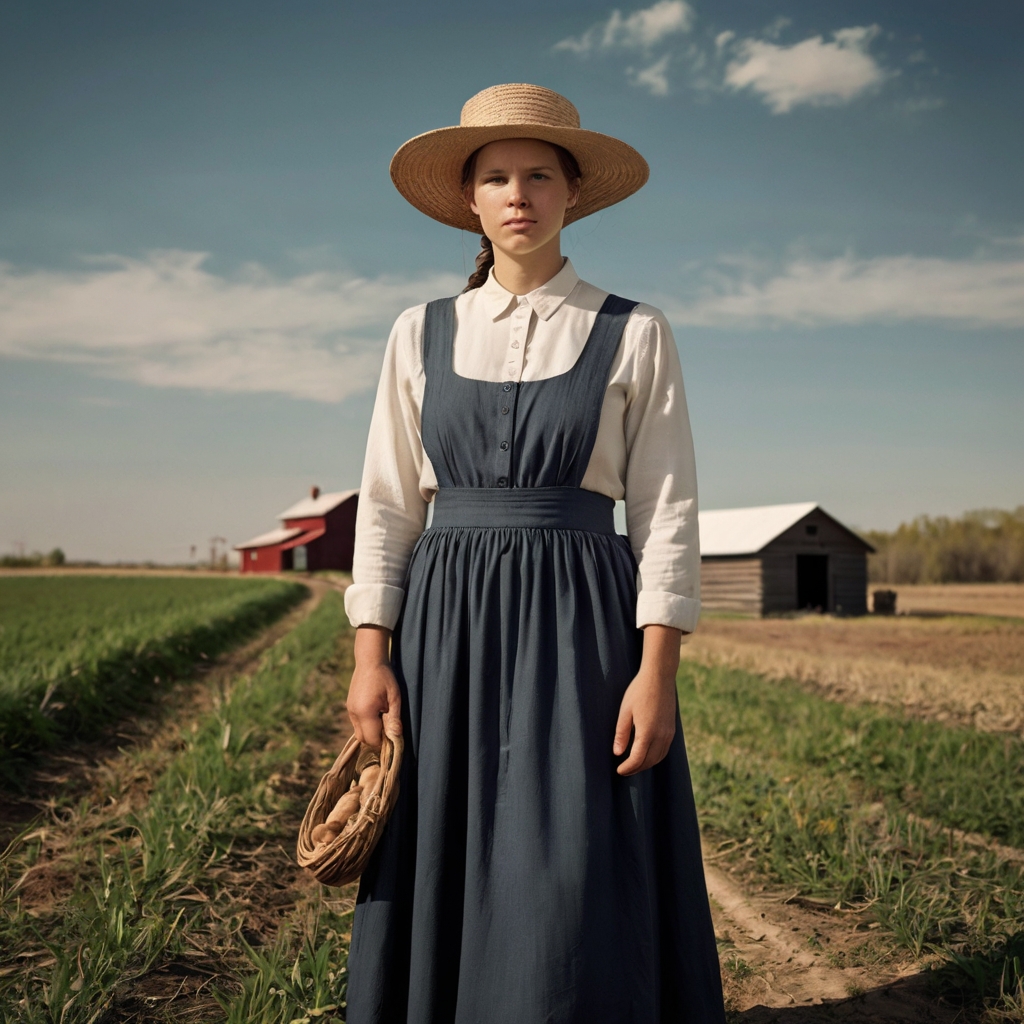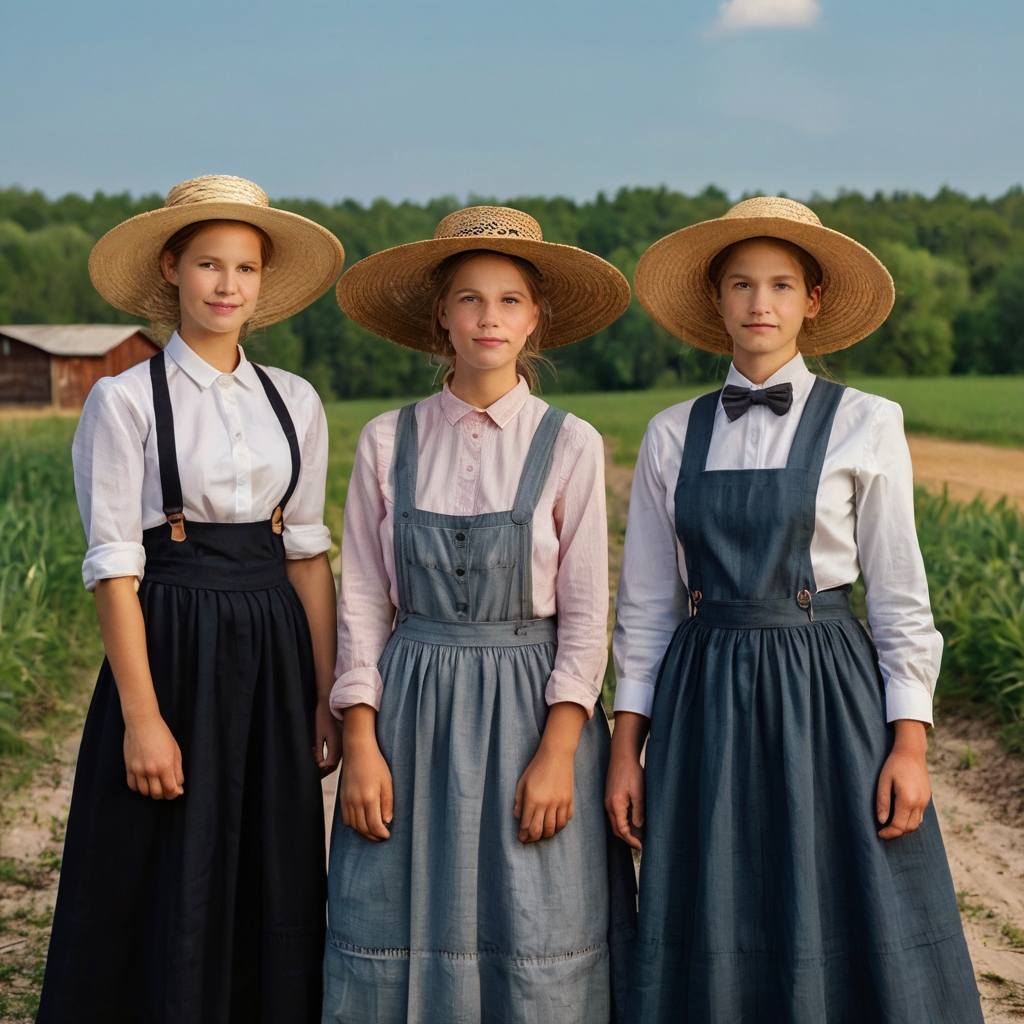The way Amish and Mennonite people dress tells us much more than their fashion priorities—it shows their unique religious identities built on centuries of tradition. These groups came from the Anabaptist Christian movement in Switzerland. The Mennonites started in 1525, and the Amish followed later in 1693. Since then, their clothing styles have changed to match their different views on faith and modern life.
A trained eye can spot the differences between Amish and Mennonite clothing right away. The Amish’s plain clothing stands out because it shows their simple lifestyle and distance from the world. Mennonites choose brighter and more modern options. The head coverings show one of the clearest differences between these groups. The Amish’s kapp (bonnet) looks bigger and stands out more. Mennonite women’s head coverings are smaller, and they have more choices in what they can wear.
These clothing choices mean something deeper than just what meets the eye. The Amish’s way of life focuses on staying away from modern influences. Mennonites keep their steadfast dedication to modesty and simplicity but interact more with today’s society. This piece will tuck into these hidden differences that most people miss, from how they choose fabrics and fasteners to what different colors mean and each community’s specific rules.

Shared Roots, Different Paths
The rich array of Anabaptist origins shows how theological differences ended up shaping the unique clothing styles that separate Mennonite vs Amish communities today.
The Anabaptist origin story
The religious movement that gave birth to both Mennonite and Amish traditions emerged during the Protestant Reformation’s tumultuous period in 16th-century Europe. A group of reform-minded Christians near Zürich, Switzerland—known as the “Swiss Brethren”—broke away from mainstream Protestant reformers in 1525. They disagreed on basic questions about faith and practice.
These early Anabaptists (meaning “rebaptizers”) believed only adults who made conscious choices about their faith should join the church. They supported a return to early Christianity’s simplicity. Their focus remained on pacifism, communal living, and staying away from worldly influences. This bold stance led to brutal persecution. Authorities executed about 2,500 Anabaptists by drowning, burning at the stake, or beheading.
Menno Simons, a Swiss Anabaptist, became the namesake of the Mennonite church. His leadership helped combine their beliefs and strengthened their steadfast dedication to pacifism.
Why the Amish split from the Mennonites
The split between Amish and Mennonite communities took shape 170 years after the Anabaptist movement started. Jakob Ammann, a Mennonite bishop, noticed what he thought was spiritual weakness within the Mennonite church in 1693.
Ammann wanted to refresh the faith with several reforms. He suggested communion services twice a year instead of once. On top of that, he supported foot washing during communion and stricter rules for plain dress. These rules banned beard trimming and fashionable clothing.
The most important disagreement focused on church discipline. Ammann pushed for strict “shunning” of excommunicated members—they would face complete social isolation if they broke church rules. The Mennonites preferred gentler methods that let repentant members rejoin their community.
These conflicts ended up creating a permanent split, and Ammann’s followers became known as the “Amish”.
How beliefs shaped clothing traditions
Clothing shows both communities’ theological commitments. The biblical principle of “nonconformity to the world” (Romans 12:2) is the life-blood of Amish and Mennonite dress codes. More biblical passages about modesty and simplicity, like 1 Timothy 2:9-10 and 1 Peter 3:3-4, guide their clothing choices.
Notwithstanding that, both groups developed different ways to apply these principles over time. The Amish managed to keep strict uniform dress codes. They preserved older clothing styles to resist outside influences. Their clothing features dark colors, homemade designs, and unique elements like hooks-and-eyes instead of buttons on outer garments.
The Mennonite communities took various approaches to dress codes based on their conservative values. Old Order Mennonites might dress like the Amish, but progressive Mennonite groups allow personal expression within modest and simple boundaries.
These clothing traditions became powerful symbols of identity and faith through the centuries. They demonstrate the visual differences between Mennonite vs Amish clothing practices that continue today.

Core Beliefs Reflected in Clothing
The profound theological framework behind mennonite vs amish clothing practices shapes everything from hook-and-eye closures to bonnets and homespun fabrics. These communities’ distinctive attire means more than just covering—it represents their deepest religious beliefs.
Modesty and humility as guiding principles
Amish and Mennonite clothing reflects biblical teachings directly. Their dress codes come straight from scripture passages that value humility over worldly display. Romans 12:2 tells believers to “be not conformed to this world,” while 1 Timothy 2:9-10 and 1 Peter 3:3-4 specifically talk about modest clothing and inner beauty’s importance over outward decoration.
Amish people take these passages literally and see their plain clothes as a shield against pride. Their clothing helps people blend in rather than stand out, which deepens their commitment to the community through a unified appearance. This dedication to humility spreads through every part of Amish dress—they use dark, solid colors and avoid decorative elements that might draw attention.
Mennonites believe in these same basic values but apply them differently. Conservative Mennonite groups follow dress codes that look similar to the Amish, though they usually allow brighter fabrics and more relaxed standards.
The role of Ordnung and church rules
You can see the difference between Amish and mennonite dress by looking at how they govern themselves. The Amish follow the Ordnung—unwritten guidelines that control proper behavior, including detailed mennonite clothing rules.
Each Amish congregation looks at its Ordnung every year. They manage to stay consistent across more than 1,700 communities without any central authority. The Ordnung covers everything from fabric choices to proper closures (many communities use hooks and eyes instead of buttons).
Both traditions use clothing to:
- Set themselves apart from the outside world
- Build group identity over individual expression
- Teach community values to children early
Mennonite communities stick to similar principles but show more flexibility. They allow more differences between congregations and let individuals express themselves within modest guidelines.
Salvation by grace vs works-based living
The biggest difference affecting amish vs mennonite clothing choices comes from their views on salvation. Many Old Order Amish communities believe in earning salvation through good works, including following community standards like dress codes.
Some Amish people aren’t sure about their salvation and view their distinctive clothing as a way to earn God’s favor through obedience. This belief creates a strong reason to keep wearing traditional clothes as a spiritual practice.
Most Mennonite groups, especially New Order communities, focus on salvation through faith in Jesus Christ. They value modest dress as a way to show their Christian faith, but their clothing choices come from thankfulness rather than obligation.
These spiritual differences explain why women mennonite vs amish clothing and men’s attire often have subtle but important variations. Amish clothing stands for strict separation and community identity. Mennonite dress—particularly in progressive congregations—tries to balance faithful expression with practical modern life.
Women’s Clothing: Mennonite vs Amish
The biggest difference in mennonite vs amish clothing shows up in women’s attire. These subtle details tell us a lot about the theological beliefs of these Anabaptist communities. Their female wardrobes give us a fascinating glimpse into how religious principles shape daily life.
Dress length, color, and fabric choices
Old Order Amish women stick to strict uniform standards. Their dresses reach the floor or mid-calf and hang loose to hide body shape. The difference between amish and mennonite dress stands out first in colors. Amish women wear solid colors – dark blues, greens, purples, and burgundies daily. Black is saved for Sunday services.
Mennonite women use more color variety. Conservative Mennonites like modest colors too, but many groups allow small prints, lighter shades, and floral patterns. Progressive Mennonite groups face fewer limits and can buy regular clothes that meet their modesty rules.
Fabric picks also show how each community views modern life. Amish women use cotton and wool, staying away from synthetics. Mennonite clothing rules change based on the congregation. Traditional groups might stick to natural fibers, while progressive ones welcome modern materials.
Aprons, capes, and undergarments
Both groups’ women mennonite vs amish clothing needs several key pieces. Amish women put on:
- A cape (triangular piece over shoulders and chest)
- A full apron over the dress
- A prayer covering or kapp
- Thick, dark stockings
Traditional Mennonite women use similar items but with key changes. They might pin their aprons instead of tying them. Some progressive groups only wear aprons in the kitchen.
Head coverings: kapp vs scarf
The mennonite vs amish head covering shows the clearest difference between these groups. Amish women wear the kapp – a heart-shaped white prayer covering made from starched organdy fabric. This shows their submission to God and husband. Girls start wearing it around age 12-13 when they join church.
Mennonite head coverings come in many styles. Conservative groups prefer smaller, see-through prayer veils called “doilies.” Other communities pick different looks, from basic scarves to modern netted coverings that blend in better.
Wedding and birthing attire
Wedding dresses show another interesting side of amish vs mennonite clothing. Amish brides wear blue dresses, not white. They keep using these as Sunday dresses after marriage. They skip rings, veils, and decorations to stay simple.
Mennonite wedding styles vary a lot. Conservative groups follow Amish-like customs while progressive ones might allow white dresses and modest celebrations.
Differences in sewing and store-bought items
The way women get their clothes marks one last key difference. Amish women make almost all clothes at home, often sewing together as a group. They learn patterns from previous generations, with older women teaching younger ones.
Mennonite dress code practices range from home-sewing traditions to buying clothes from stores and making them modest. This shows how Mennonites keep their simple values while adapting to today’s world.
Men’s Clothing: Subtle but Telling
Men’s mennonite vs amish clothing shows subtle yet meaningful differences that tell us a lot about how each community balances tradition with modern life, setting them apart from their female counterparts.
Shirts, trousers, and suspenders
Amish and Mennonite men might look similar at first. Both groups wear solid-colored shirts, broad-fall trousers (pants with a flap front instead of a zipper), and suspenders rather than belts. The difference between amish and mennonite dress becomes clear through their choices of colors and how their clothes fit.
Amish men stick to white shirts for Sunday services and darker shades for everyday activities. Their handmade trousers stay black or dark blue. Mennonite men’s choices depend on their congregation’s mennonite clothing rules. They often wear more colors and buy their clothes from stores while staying true to modest principles.
Beards, hats, and grooming rules
Facial hair might be the most noticeable sign in amish vs mennonite clothing customs. Married Amish men grow beards but skip the mustache. This practice goes back to their peaceful beliefs and rejection of military culture that linked mustaches to soldiers. This clean-shaven upper lip sets them apart from both the outside world and their Mennonite neighbors.
Hats also show which community a man belongs to. Black broad-brimmed hats mark Amish church attendance, and straw hats suit their fieldwork. Conservative Mennonites wear similar styles with small changes in brim width and crown height that point to their specific group.
Workwear vs formal wear
Each group keeps special clothes for work and worship. Amish men put on black suits with matching vests for Sunday best. Their Mennonite neighbors might choose navy or dark suits based on their congregation’s mennonite dress code.
Daily work calls for practical choices. Both groups need tough clothes that hold up during manual labor. Progressive Mennonites sometimes add modern workwear that stays within their modest guidelines.
Use of buttons and accessories
The biggest clue in what do mennonites wear comes down to buttons. Many Amish groups don’t allow buttons on outer clothes, especially coats and vests. They use hooks and eyes instead because buttons once stood for military pride. Mennonite men can use buttons on all their clothes.
Both groups keep accessories simple. Some Mennonite men wear basic watches or plain wedding bands, but most Amish communities don’t allow these items.
Hidden Details You Might Miss
Mennonite vs amish clothing shows more than just what meets the eye. The subtle details in their garments tell a deeper story about their values and beliefs.
Closures: buttons vs hooks
The way clothes fasten marks the biggest difference in amish vs mennonite clothing. Amish people don’t use buttons on their outer garments. They opt for hook-and-eye closures because buttons remind them of military uniforms. The women use straight pins to hold their dresses together instead of zippers or buttons [271]. Mennonite groups take a more open approach and let their members use buttons on all clothes.
Fabric weight and texture
The choice of fabric adds another layer to the difference between amish and mennonite dress. Both groups want clothes that last and serve a purpose. Amish folks prefer Triblend denim made from cotton, polyester, and rayon because it lasts longer [263]. When summer comes around, Amish women switch to light broadcloths that don’t wrinkle as much as heavy polyesters [251].
Color symbolism and community rules
Each community’s Ordnung (unwritten rules) guides their color choices. Amish communities stick to solid colors, and the most conservative groups wear darker shades [261]. Mennonite clothing rules give more freedom with prints and brighter colors based on how traditional each congregation stays.
Seasonal clothing differences
The weather shapes what both groups wear. Amish men swap their dark winter hats for straw ones in summer [271]. Neither group allows shorts at any time, and men must wear long sleeves to church [271].
Differences in children’s clothing
Kids dress like their parents but with small changes. Amish boys wear lighter versions of their dads’ clothes – think light blue instead of navy denim, or light gray suits instead of dark ones [251]. These subtle changes show a child’s journey toward becoming a full community member, something people often miss when comparing women mennonite vs amish clothing.
Sumig all up
Amish and Mennonite clothing traditions represent much more than style choices. These garments powerfully express their theological beliefs, community values, and their relationship with modern society. Both groups share Anabaptist roots and value modesty, humility, and simplicity. Yet their different paths have created notable variations in their dress codes.
The Amish embrace strict uniformity in their clothing. Dark colors and hook-and-eye closures showcase their steadfast dedication to staying separate from worldly influences. Mennonite clothing offers more flexibility and personal expression while upholding modest principles. The differences go deeper than what meets the eye. Men’s hats, beard styles, and women’s head coverings all carry unique significance.
The rules governing these clothing traditions highlight key theological differences. The Amish Ordnung follows a works-oriented faith approach. Most Mennonite communities focus on salvation through grace. What outsiders might see as simple fashion choices actually symbolizes deep spiritual commitments.
These hidden differences reveal the rich cultural heritage preserved through distinct clothing practices. Casual observers might see similarities between these communities. Their attire tells a deeper story of religious identity, community belonging, and careful balance of tradition in today’s faster-changing world. These clothing traditions remain vital expressions of faith that set Amish and Mennonite communities apart, even after centuries of social change.
Here are some FAQs about mennonite vs amish clothing:
Do Mennonites dress the same as Amish?
When comparing Mennonite vs Amish clothing, there are noticeable differences in style and modesty standards. While both groups value simplicity, Amish vs Mennonite clothing shows the Amish typically maintain more traditional, uniform attire. The women Mennonite vs Amish clothing distinction is especially apparent in everyday wear and use of modern fabrics.
What is the difference between Amish and Mennonite bonnets?
In examining Mennonite vs Amish vs Quaker clothing, Amish bonnets tend to be stiffer and more standardized in shape and color. The woman Mennonite vs Amish clothing comparison shows Mennonite head coverings are often smaller and more varied in style. Women Mennonite vs Amish clothing choices reflect their respective community’s interpretation of biblical modesty guidelines.
Do Mennonites get along with Amish?
While sharing Anabaptist roots, relationships vary between groups when considering their differing practices like Mennonite vs Amish clothing. The Amish vs Mennonite clothing differences symbolize deeper theological and cultural distinctions. However, many Mennonite and Amish communities maintain respectful neighborly relations despite lifestyle variations.
Which is more strict, Mennonite or Amish?
Generally, Amish communities maintain stricter standards than Mennonites, evident in comparisons of Mennonite vs Amish clothing. The women Mennonite vs Amish clothing rules demonstrate this, with Amish typically having more rigid dress codes. When evaluating Mennonite vs Amish vs Quaker clothing traditions, the Amish usually represent the most conservative interpretation.
Why are there Mennonites in Mexico?
Mennonite communities migrated to Mexico seeking religious freedom and farmland, bringing their distinctive Mennonite vs Amish clothing traditions. Unlike the more isolated Amish, these Mennonites adapted some modern conveniences while maintaining their faith. The women Mennonite vs Amish clothing in Mexican communities reflects this balance of tradition and adaptation.
Can Mennonites marry non-Mennonites?
Marriage policies vary among Mennonite groups, with some permitting outside marriages more than the Amish would. This flexibility parallels differences seen in Mennonite vs Amish clothing allowances. While women Mennonite vs Amish clothing shows visible distinctions, marriage rules represent deeper theological and cultural boundaries between the groups.









